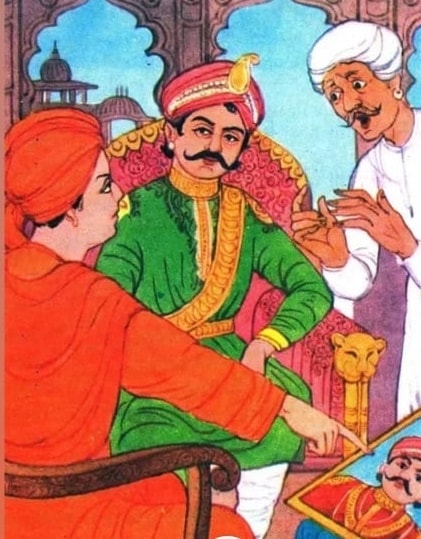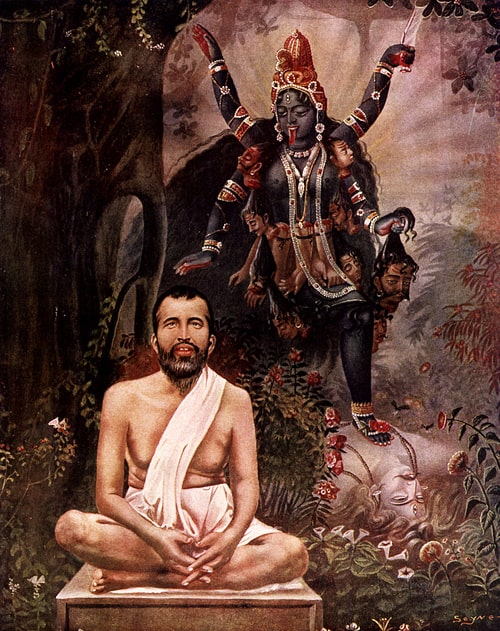Date: April 1, 2025
Part 2: Symbolism in Murti Puja
Continued from Part 1
During his Parivrajaka days when Swami Vivekananda was travelling all over India on foot, he happened to be visiting the princely state of Alwar in Rajasthan. Raja Mangal Singh, the king of Alwar told him that he did not believe in image-worship as he could not worship wood, stone or metal. Swamiji tried to make him understand but he remained unconvinced.

Suddenly, Swamiji asked one of the attendants to take down a picture of the Maharaja from the wall. Holding the picture in his hand, Swamiji asked the Dewan of Alwar to spit on it. At this the Dewan grew terrified and said, “What? How can I do such a thing? This is the likeness of our Maharaja!”
On hearing this, Swamiji said to the king, “See, Your Highness, though this picture is only a piece of paper, your devoted servants treat it with respect because it reminds them of your Highness. Similarly, devotees worship God in an image because it brings to their mind some special form of God and helps them to concentrate; they do not worship the stone or metal as such.” At this the Maharaja said with folded hands, “Swamiji, till now I did not understand the meaning of image worship. You have opened my eyes.”
A vigraha or an image is never just an image. It is not the lump of clay that is worshipped but what lies beyond it. True religion is the experience of the Reality behind the Appearances. But not all are capable of attaining that height. The climb has to be gradual. Vigrahas work on this principle.
An image is an attempt to catch the Infinite through the senses. Brahman is beyond all concepts and images anyway. That is the reason why there are numerous gods and goddesses in Hinduism. If ultimately the Infinite cannot be expressed – there is no harm in having as many expressions, as many images as you want – depending on your taste and temperament. For the Nameless, you can have as many names as you want; for the Formless, you can have as many forms as you want; it doesn’t really matter. The Infinite is One and if it has to be represented in finite terms – we can have as many as we want – because all are inadequate.
Image worship is about bringing down the Infinite to the level of our senses. Then we can talk to it, worship it, complain to it and thank it – depending upon our varying moods. When you love a person – you want to see and touch that person. You praise that person. You get angry with that person. Image worship has all these elements in it. Man is a creature of the mind and is dominated by matter. So he brings the Divine down to the level of his body and mind. Images are “veils mercifully granted to the common to spare his eyes the too dazzling nakedness of truth” (Swami Vivekananda).
Things like Brahman, Tao, Shunya are not for common people. They cannot grasp them. Swami Vivekananda says:
“The clear light of truth very few people in this life can bear, much less live up to. It is necessary therefore, that this comfortable religion should exist. Small minds whose circumference is very limited and which require little things to build them up, never venture to soar high in thought. Their conceptions are very good and helpful to them, even if only of little gods and symbols.”
Buddha tried to keep all sorts of rituals and image worship out of his religion. His emphasis was always on the inner discipline, on the Eightfold Path. He repeatedly stressed that he was not a divine being, that he was an ordinary man who attained enlightenment by dint of his efforts, and that anyone could attain it if he tried – because Nirvana is our essential nature. No images, no worship, no rituals in his teaching. But the irony is, he himself became an idol! He is now worshipped as God with elaborate rituals!
So this cannot be helped. This human tendency to bring down the Infinite to the finite cannot be avoided. And there is no harm in it. Because we are all on different stages of our spiritual evolution, we need symbols and supports during our growth. We should not be in too much of a hurry to destroy the images unless we have firmly established in our minds and our hearts the Reality which the images represent.
In The Synthesis of Yoga, Sri Aurobindo writes,
“But while it is difficult for man to believe in something unseen within himself, it is easy for him to believe in something which he can image as extraneous to himself. The spiritual progress of most human beings demands an extraneous support, an object of faith outside us. It needs an external image of God; or it needs a human representative, —Incarnation, Prophet or Guru; or it demands both and receives them.
“For according to the need of the human soul the Divine manifests himself as deity, as human divine or in simple humanity—using that thick disguise, which so successfully conceals the Godhead, for a means of transmission of his guidance. The Hindu discipline of spirituality provides for this need of the soul by the conceptions of the Ishta Devata, the Avatar and the Guru.”

The human mind in its present state of spiritual infancy cannot raise itself to the rarefied heights of pure contemplation and meditation on the Infinite. Weighed down by the constant pulls of desires and anxieties, it is not sufficiently capable of taking a flight into the Nameless and Formless. For this, it needs aids for concentration to be able to sit in meditation. That is why the method of upāsana had been developed from the earliest Vedic times.
Each devotee chooses his own vigraha, his Ishta Devata based on his personal temperament. The Infinite is like water, which though it is formless, assumes the shape of the vessel in which it is poured. The Kularnava Tantra, an important Tantric text says:
Sadhakaanam hitarthaya Brahmano rupakalpana
For the benefit of the Sadhaks, Brahman has been conceived in different forms.
Ultimately it is the Nameless, Formless, Infinite and Eternal Brahman that is the foundation of all image worship. And the sages and Rishis who devised this multiplicity of vigrahas for worship knew that:
Akaashat patitam toyam yatha gacchati sagaram
Sarva deva namaskara Kesavam pratigacchatiAs all rain falling from the sky reaches the ocean; so also, the prayers to all the Gods, ultimately go to Lord Kesava.
~ Maha Subhashita Sangraha, 4289
By whatever name we call, whether it is Rama, Krishna, Shiva, Devi or Ganesha – ultimately all our prayers reach the One Infinite Source, provided we are sincere in our worship. As for the images, only the supreme vision of the Drasthas (seers) could conceive such Vigrahas that conveyed the highest metaphysical concepts that every heart soaked in devotion could approach. Salutations to those Drashtas who conceived the vigrahas.
We shall explore the symbolism of a few vigrahas in the forthcoming blogs.
